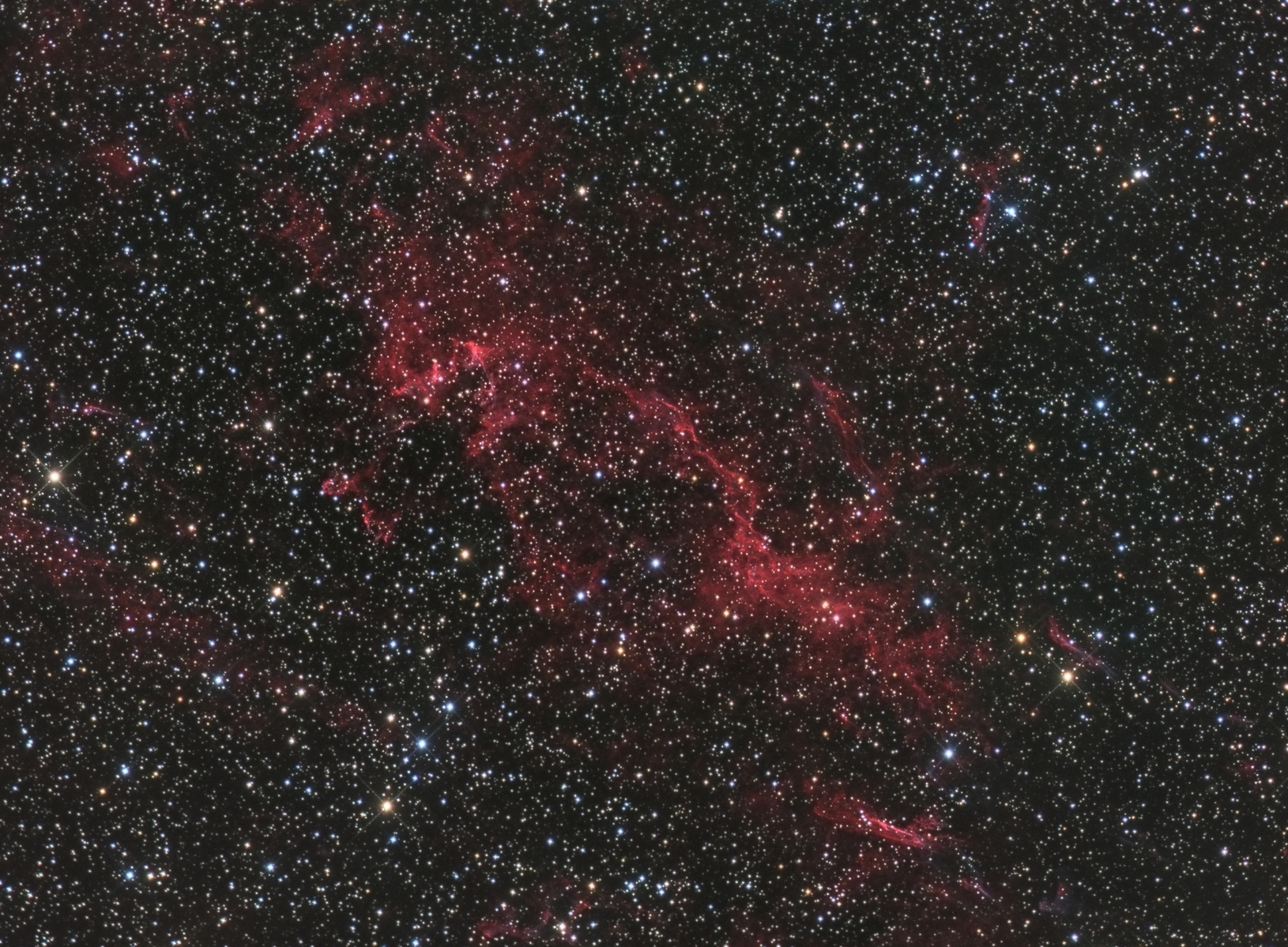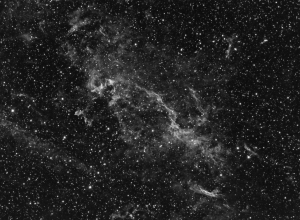NGC6979, The Veil Nebula
 Click image for full size version
Click image for full size version
September 30, 2015
The Veil Nebula is a huge and complex supernova remnant located in Cygnus. I have shot the eastern and western sections of the Veil before, and the entire nebula with a wide field scope. NGC6979 seems to be rarely imaged, so I went after it in this shot. It is jeast of Pickering’s Triangle, northwest of the eastern Veil. Unlike some other portions of the Veil there are very few teal-coloured filaments in this part of the complex. The gases in this nebula are glowing due to shock waves from the explosion that formed the nebula. It took me more than 5 weeks to collect the more than 22 hours of light that went into this image!
 The colour image above blends the red, green and blue channels with data collected through a deep red H-alpha filter that lets in just the light emitted by hydrogen atoms. The black and white image at right shows the H-alpha data alone; click on the image to see it full size. The eye is better at picking out detail in black and white images than colour images. The stars are smaller in the Ha version because most starlight is emitted at wavelengths other than H-alpha. The colour and mono versions complement each other, and I hope you enjoy them both.
The colour image above blends the red, green and blue channels with data collected through a deep red H-alpha filter that lets in just the light emitted by hydrogen atoms. The black and white image at right shows the H-alpha data alone; click on the image to see it full size. The eye is better at picking out detail in black and white images than colour images. The stars are smaller in the Ha version because most starlight is emitted at wavelengths other than H-alpha. The colour and mono versions complement each other, and I hope you enjoy them both.
Tekkies:
SBIG STL-11000M camera, Baader L, Ha, R, G and B filters, 10″ ASA astrograph operating at f/6.8, Paramount MX. Guided with QHY5 and 80 mm f/6 Stellar-Vue refractor. Acquisition and guiding with TheSkyX. Focusing with FocusMax. Automation with CCDCommander. Calibration, cosmetic correction, registration, integration and all processing in PixInsight. Shot from my SkyShed in Guelph, Ontario. Nearly full Moon for Ha and no moon for LRGB. Good to very good transparency and average seeing throughout acquisition.
12x15m R, G and B; 18x30m Ha; 26x10m L unbinned frames (total=22hr20m).
HaRGB
Creation and cleanup: L, R, G, B and Ha masters were cropped and processed separately with DBE. The R,G and B channels were combined and the resulting RGB image was processed with ColorCalibration. The NB-RGBCombine Script was applied to Ha and RGB with default settings to produce a linear HaRGB image. PixelMath was used to boost the blue by adding 5% Ha.
Linear Noise Reduction: MultiscaleLinearTransform was used to reduce noise in the background areas of the HaRGB image. Layer settings for threshold and strength: Layer 1: 3.0, 0.5 Layer 2: 2.0, 0.35 Layer 3: 1.0, 0.25 Layer 4: 0.5, 0.1
Stretching: HistogramTransformation was applied to make a pleasing yet bright HaRGB image. TGV Noise was applied and the image was re-stretched to reset the black point.
Synthetic Luminance and H-alpha only
Creation and cleanup: The cleaned up L, Ha, R,G and B masters were combined using the ImageIntegration tool (average, additive with scaling, noise evaluation, iterative K-sigma / biweight midvariance, no pixel rejection). The Ha master was copied, with the copy used for the Ha-only image.
The following steps were done in parallel on both the SynthL and Ha-only masters.
Deconvolution: A copy of the image was stretched to use as a deconvolution mask. A star mask was made from unstretched SynthL to use as a local deringing support. Deconvolution was applied (100 iterations, regularized Richardson-Lucy, external PSF made using DynamicPSF tool with about 20 stars; local deringing at 70% and global dark deringing at 0.02).
Linear Noise Reduction: MultiscaleLinearTransform was applied to reduce the noise. Layer settings for threshold and strength: Layer 1: 3.0, 0.5 Layer 2: 2.0, 0.35 Layer 3: 1.0, 0.2 Layer 4: 0.5, 0.1
Stretching: HistogramTransformation was applied to make a pleasing yet bright image. TGV Noise was applied and the image was re-stretched to reset the black point.
HDR Multiscale Transformation: HDRMT was applied at 6 and 4 pixel scales using a mask to protect stars. LHE was applied at scales of 50 and 150 using the same star mask (strength 0.25 for both).
Combining SynthL with HaRGB:
The luminance channel of the HaRGB image was extracted, processed and then added back into the HaRGB image as follows:
1. Extract luminance from the HaRGB image.
2. Apply LinearFit using SynthL as the reference.
3. Use ChannelCombination in Lab mode to replace the HaRGB’s luminance with the fitted luminance from step 2.
4. LRGBCombine was then used to make a SynthLHaRGB image.
Final Processing
SynthLHaRGB: Star shapes were smoothed and sizes reduced by applying MorphologicalTransformation through the same star mask using first the Midpoint operator with default settings and then erosion (6 iterations with a strength of 0.1). A light unsharp mask was then applied to the stars. The star mask used previously was used to increase colour in the stars using the Curves tool. A range mask for the brightest highlights minus stars was made by subtracting a star mask from a range mask. The highlights were sharpened slightly with unsharp mask. Overall contrast and brightness were increased slightly with the Curves tool.
Ha only: The highlights were sharpened slightly with unsharp mask. Overall contrast and brightness were increased slightly with the Curves tool.
Image scale is about 1.1 arcsec per pixel for this camera / telescope combination.






Leave A Comment